Hello Paneristi,
the following information is not a Wikipedia about Panerai (Wiki) but tries to give new Paneristi a general overview about Panerai model(s), their evolution, typical naming/expression, and the use of our database.
We start with general information that fits to all Panerai watches and goes deeper to the specific collections with types of cases and dials.
You will find at the end (chapter 9 & 10) recommendations for the use of “THE Panerai Reference Database” & typical naming & abbreviations.
1. Series
At Panerai exists letters for production years and fiscal years.
Production year “A” starts with 1998, fiscal year “A” starts with 1999 (called A series).
Only the production year is relevant at the fan-base because it is displayed on each watch.
Following you can see all series (production years):
A 1998, B 1999, C 2000, D 2001, E 2002, F 2003, G 2004, H 2005, I 2006, J 2007, K 2008, L 2009, M, 2010, N 2011, O 2012, P 2013, Q 2014, R 2015, S 2016, T 2017, U 2018, V 2019, W 2020, X 2021, Y 2022, Z 2023, AA 2024.
“PreA” series is used as expression during acquisition and short after acquisition of Panerai by Richmont before the series wording was introduced (1997).
2. Millesimation
Millesimation shows you the production limitation for a specific year (e.g. 1000). Because of that, all Panerai watches have a kind of limitation. On the watch bottom site, you will find the information in the form: “Series (Production year)” “specific watch number out of” / “Millesimation (limitation)” e.g. S0511/1000 (means in year 2016 the 511th produced watch out of 1000).
2.1 Out of Range
For some reason, Panerai produced few specific references outside the Millesimation. That is called “Out Of Range (OOR)”. In those cases, you will find the information OOR0025/0100 on the bottom side of the watch. Here you have no information about the specific production year. For example review OOR at PAM00002 with 100 pieces & PAM00217 with 11 pieces.
2.2 Shadow Case
Special produced watches for fairs & presentations have no Series & Millesimation, but the usual serial numbers like “Case Number” & “Case-Type-Number”. Sometimes that watches are delivered for promotion to some VIPs.
That kind of watches find the way to the second-hand market in very rare cases.
3. Serial Numbers
Panerai watches bear four serial numbers.
- Millesimation: Most used number in Panerai fan-base (description see at Millesimation)
- Case number: Starts with two letters, followed by digit numbers. Most used letters are BB, additional used letters are DB, DT, PB, PL, PN, PT, SM, SW, FT.
A clear usage system about the letters is not known, maybe declare the combination of used case materials, like SW for wood, PN is used for Ceramica or Carbotech models, DT is used mostly for Composite. The rendered pictures on the Panerai website show mostly a BB, nevertheless real produced watches of same reference have often other letters. It can be also a production location code, because most cases have a BB, exotic materials have unusual combination.Caution: Panerai used during the first years mostly PB & BB, but the documentation about that is even at Panerai ABC (handbook) not complete. We recognized that the documentation at Panerai around year G is patchy. very often documented letters are BB, but additionally PB was used or vice versa.
- Case-Type-Number: Case-Type-Number beginning with “OP”, followed by a four-digit number. First numbers started with 6500, after ~20 years new cases have today a number around 7600 (e.g. OP 7571).
-
Movement number: Movement number is mostly a simple digit number.
4. References
The reference is a specific Panerai watch model, that is produced one or more years. The full naming begins with PAM* followed by 5-digit number (e.g. PAM00127). Until 2015 Panerai used only the last three numbers. Because of that most Paneristi do not write the first two digits (e.g. PAM127, or only the digit 127 instead of PAM00127).
Additionally, some references have an own naming in the fan-base (e.g. PAM00127 is called Fiddy).
*PAM means “Panerai Model”, because of the letters PAM as part of the reference, most Paneristi name the Panerai watch simply “Pam”.
You can classify the references in four groups how they were limited and/or sold:
Standard reference (SR): Produced in volumes about 500-8000 pieces p.a.
Limited edition (LE): Produced in smaller volumes about 500-2000 pieces for a limited time (e.g. 1-3 years)
Special edition (SE): Produced fixed volumes (that was defined in advance), ~2-~2000 pieces
Boutique edition (BE): Produced fixed volumes (that was defined in advance) for a specific boutique, volumes very low from ~20-~200 pieces (many Paneristi references belong to that category). That reference has an attribute linked to the specific boutique or their customer (mostly naming a/o picture on the case back).
The following categories you can see as subcategories from the first four, but with additional features/exclusivity.
Boutique exclusive (only): A specific Panerai reference (can be a SR but mostly LE & SE models) will be offered only (at least in the beginning) at Panerai boutiques. The reference himself has no specific attributes linked to the boutiques. That is a marketing instrument for a higher exclusivity.
Online exclusive: A specific Panerai reference will be offered only (at least in the beginning) via e-commerce from Panerai himself (“B2C” without any retailer). An example is the PAM731 or the PAM01055. In past there was SR/LE/SE references used.
Event edition: Since 2019 Panerai sells some LE references (e.g. PAM00760) only at Panerai events at guests. You have got an event invitation to get that model. That is a marketing instrument for a very high exclusivity and to know the customers in person.
Experience (Xperience) edition: Since 2019 Panerai sells some LE references in combination with an adventure event (lasting several days). It can be an Panerai internal event (sailing with the sailing vessel “Eilean”) or with partners (e.g. Brabus, Comsubin, Luna Rossa) or ambassadors (e.g. Mike Horn).
On request: In 2016 Panerai started to produce very exclusive references only on request. The customer was able to order the preferred reference in different variation (e.g. case material). In 2019 Panerai established a catalog of cases, materials, hands, dials and movements where the customer can customize his preferred combination. That catalog is called “Su misura” (we published the known information under the reference “PAM99998” at the collection “Set”. That are the most expensive and unique Panerai models.
Concessionaire edition: Panerai produces sometimes special references (mostly LE) for big retailer. That reference will be sold only at the shops from that specific retailer (e.g. PAM01021 for Bucherer).
5. Evolutions
Changes during production of a reference are called “Evolution” and they are described in the Panerai ABC handbook (official Panerai dealer book). Nevertheless, not all changes are stated by Panerai (e.g. changes of the design of the dial like “long arrow” or “short arrow” at PAM00005).
Typical changes are:
- New engravings on the case
- Changes on parts (e.g. crown protector)
- Changing dials technique (e.g. from painted to sandwich or vice versa)
- Changes on dial design (e.g. move from Base dial to All Numbers, adding/removing “pig”)
- Changes on movement (e.g. remove date function, changing “dot” to AM/PM hands)
- Changes on strap or adding additional strap
- Change crystal from plexi to sapphire or vice versa
- Change from open case back “see-through crystal” to closed case back (or vice versa)
- Changes strap fixing on case (e.g. from screwing to “casing without screws” or vice versa)
- Case-Type change comes along with bigger changes (e.g. OP 6837 to OP 7068)
To know which evolution a specific reference has, you have to know the specific production year (called series). A typical question from a Paneristi is “from which series is that PAM?”.
Following you can see some comparison of evolutions.
Evolution: Updated Logo on the crown
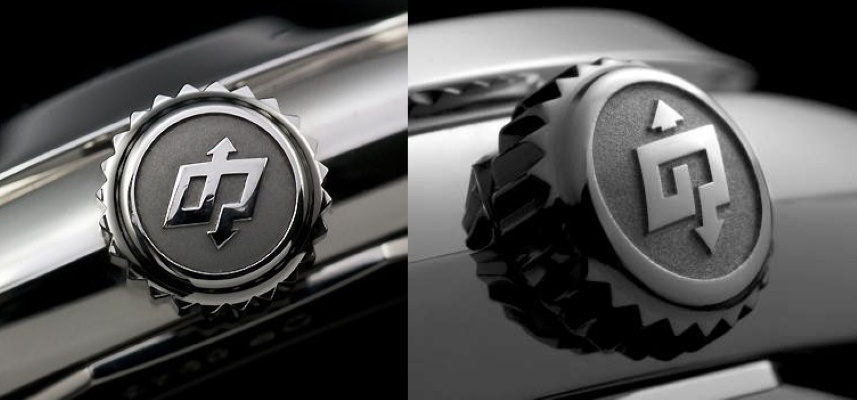
Evolution: Luminor casing without screws
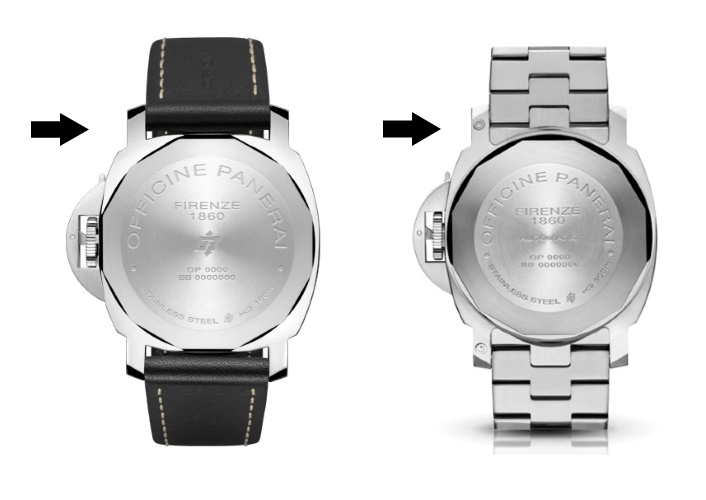
Evolution: Luminor 1950 casing without screws

Evolution: 24h Indication with hand instead of disk (dot to AM/PM)

Evolution: Torpedo removed from the dial (that torpedo is called “pig” at Panerai fan-base)
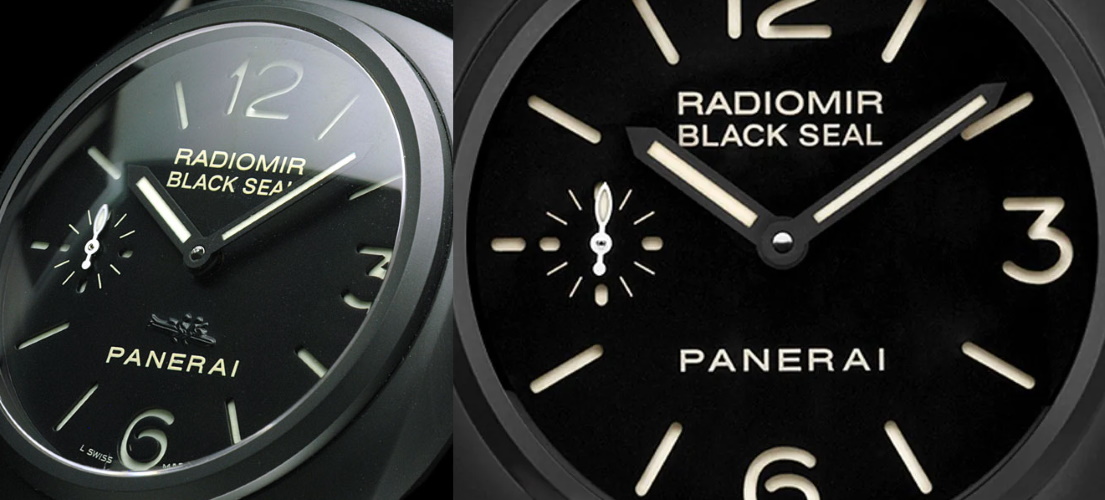
6. Dial types & specialties
The variations of dials you can split in two groups. First group is with which technique the numbers and lines were applied to the dial. Second group describes the design of the dial.
6.1. Technical methods
In the first group we differentiate between the “Sandwich dial”, “Painted dial”, “Sausage dial”, “Printed dial”, “Hollowed dial” and “Connected pins & dots”.
Sandwich dial
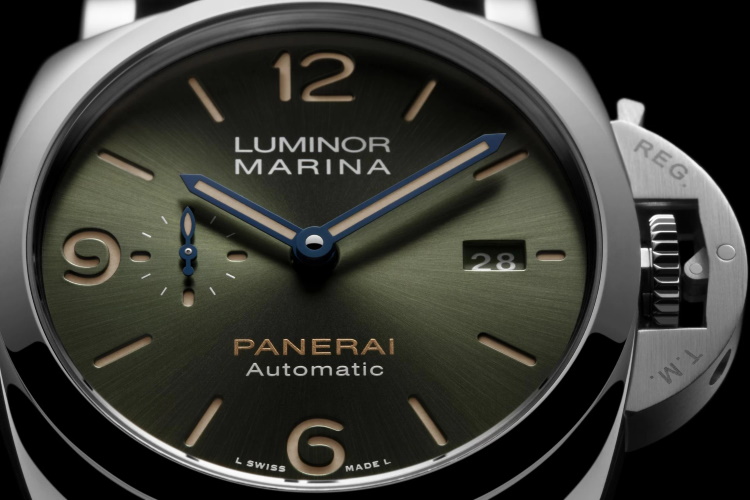
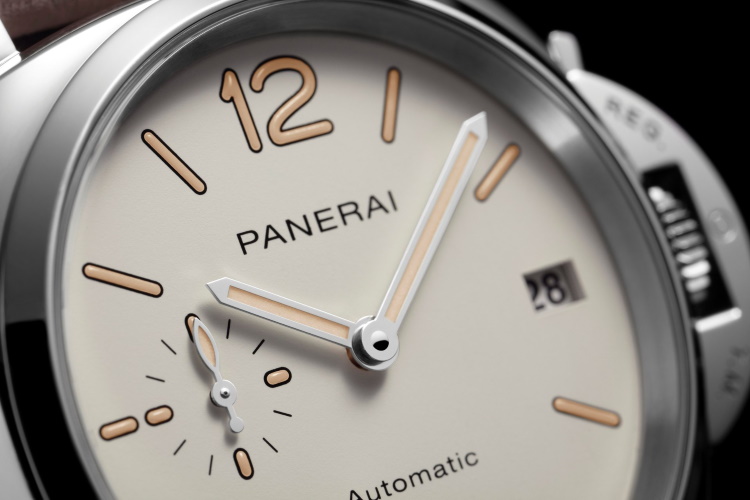
Painted dial
Sausage dial
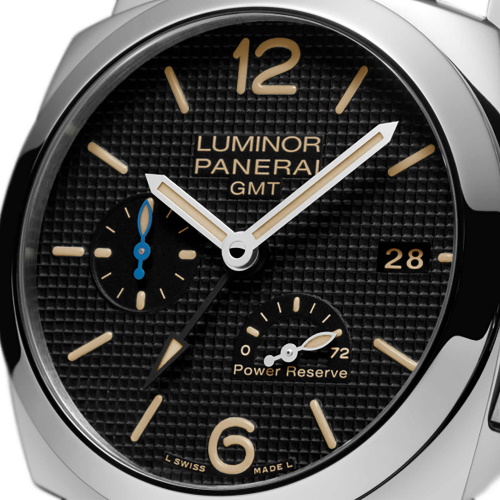
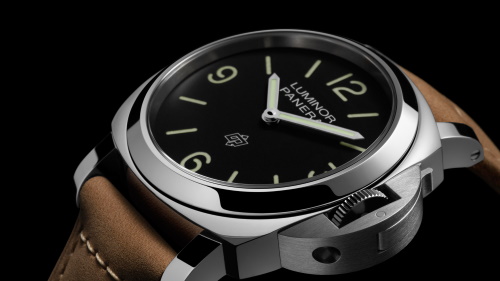
Hollowed dial
The dial sheet is minimal debossed and filled up with Luminous material. The dial has a smooth surface like a printed dial, but with luminescence. It has no three-dimensional effect.
Printed dial
Printed numbers and lines without luminous effect on the dial (sometimes Panerai added luminous painted dots on the edge of the dial to get minimal luminosity).
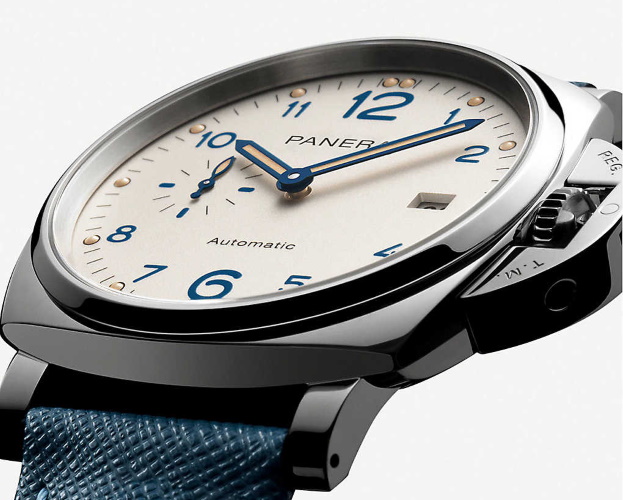
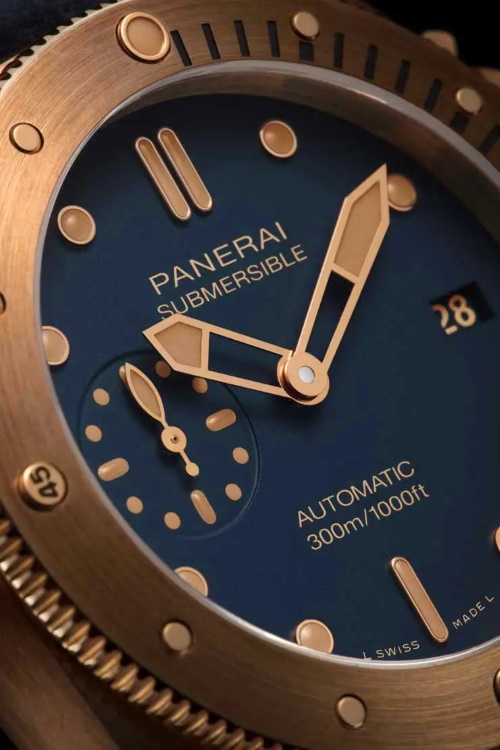
Connected pins & dots
That dial has no specific name in the Panerai fan-base. All pins & dots are connected on the dial. Because of that the dial has a three-dimensional effect. It is used mostly for the Submersible collection in combination with the S.L.C. dial style.
6.2. Design layout
The second group we differentiate between the layout, look & feel of the dial.
Base dial
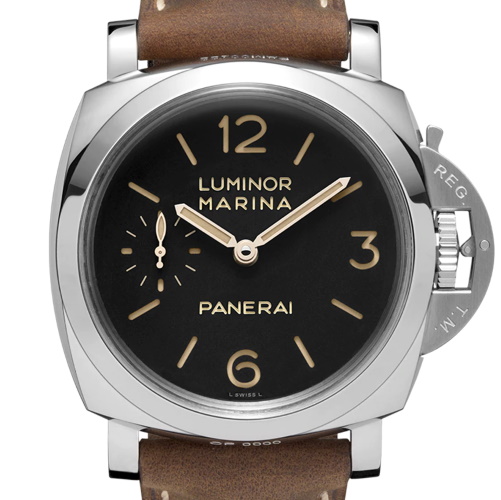
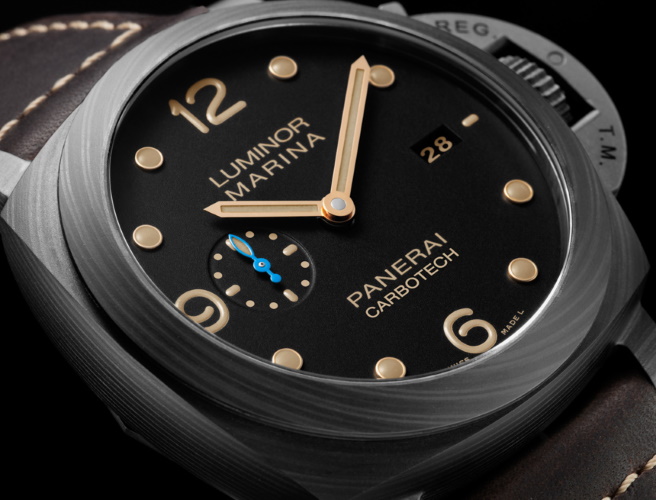
Base dial with dots instead of lines
California dial
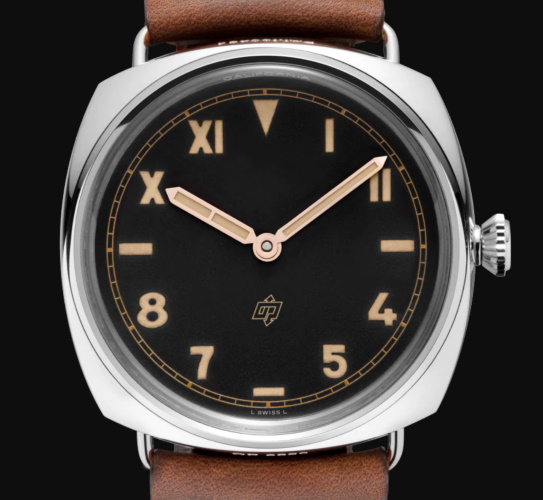
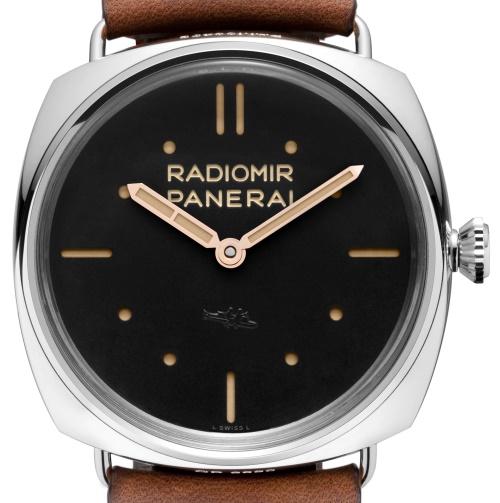
S.L.C. dial
S.L.C. dial with lines instead of dots
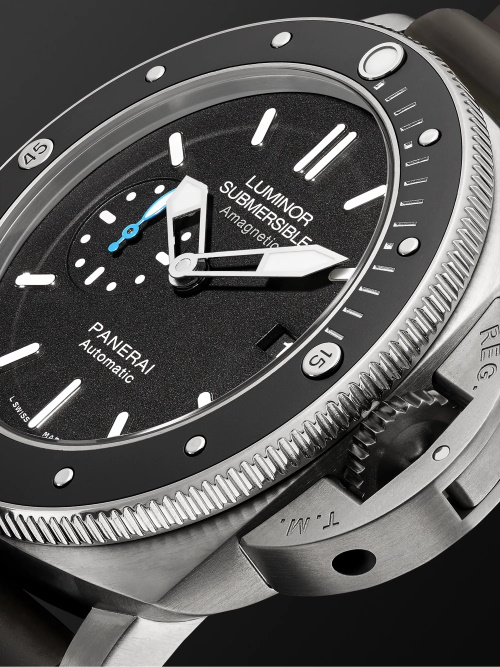
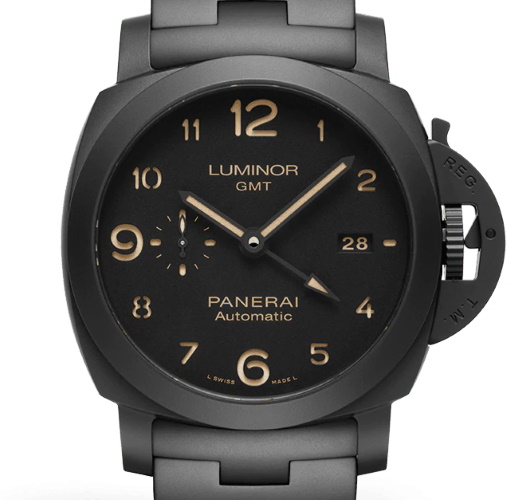
All Numbers
6.3. Used Luminous Materials
The naming on the dial under the number “6” depends on the used luminous material.
The naming "T SWISS T" and "T SWISS MADE T" are used in case of Tritium luminous material (replacement started in 2006/2007 to Super-Luminova). It is unclear if Panerai will use Tritium in the future because of the low radioactivity (only touchy if watch is open for maintenance or the topic waste disposal). Last watch with Tritium was the PAM00285 in 2008.
"L SWISS L" is used for Luminova, it was replaced at most series by Super-Luminova, starting from 2004/2005. Nevertheless, Luminova is still used for classic series (e.g. PAM01075).
"L SWISS MADE L" is used for Super-Luminova. New Panerai models use mostly Super-Luminova.
Misleading is the understanding of which material is “better”. Tritium is low radioactive. It does not need light to “load up”. Because of that it was used mostly for professional watches like for deep diving.
Luminova and Super-Luminova need light to “load up”. Super-Luminova has a much higher glow (also called luminance). It releases the saved energy much faster. Because of that it is also much faster “empty”. Super-Luminova glows between 2-5 hours in darkness. Luminova glows slighter but up to 24 hours. Misleading is also the meaning that Super-Luminova as advancement of Luminova is at all areas better. Super-Luminova glows stronger, but Luminova glows longer.
Generally, the naming and quality of used luminous materials is more a marketing tool at all watch brands (including Panerai), because that material was invented by only one company and is still produced from them in Japan and in Switzerland (another company produces in license the same product). All brands buying from them the finished product or mixes the bought luminous material with own colors (that has no positive impact on the glow characteristic).
7. Components
7.1. Movements
Panerai has a wide range of movements because of the huge range of watch sizes (from 38mm until 60 mm case size). That explain the variation of movement names.
Panerai has an old and a new naming system for movements.
Old Naming System “OP”
The old movement naming system at Panerai starts with the letters “OP” followed by Roman numeral (e.g. “OP I”, “OP II”,). In the beginning Panerai had no facilities to produces own movements (was very common at that time) and bought all movements from movement manufacturer. Because of that the OP-naming is strongly connected at Panerai fan-base with purchased movements. Most movements were modified or finished for Panerai exclusively. At our data base you will find the basis caliber and producer name.
The old naming system was simple. Each new movement was introduced via increasing the Roman number (from I to XXXIV). The last movement in that naming system was the “OP XXXIV” introduced in 2017 and renamed to “P.900” in 2018.
New Naming System “P.”
The new movement naming system was introduced with the first own Panerai movement “P.2002” in 2005. Because of that the new naming system is strongly connected to “in-house” at the Panerai fan-base (nevertheless, there was some exceptions in past and Panerai did not confirm until now that view or show their own definition * about that topic).
The naming starts with “P.” followed by 3-4 digits (e.g. P.4000). Additional functions/features are reflected by increasing the last digit (e.g. P.4001) or adding a “/” follows by digit(s) or letter(s) like P.4000/10 or P.4001/S.
The new naming system classified by manual or automatic winding:
- Manual winding: P.999 family, P.1000 family, P.2002 family, P.2004 family, P.2005 family, P.2006/3, P.2015/T, P.3000 family, P.5000 family, P.6000
- Automatic winding: P.900 family, P.2003 family, P.4000 family, P.4100, P.9000 family, P.9100 family, P.9200
The new naming system classified by functions & volumes:
- Standard movements (P.999, P.1000, P.6000). Functions limited to hours, minutes, small seconds, date, seconds reset. Produced in high volumes.
- Platform movements (P.3000 family, P.4000 family, P.5000 family, P.900 family, P.9000 family). That movements exists with many variations and additional functions but produced in high volumes.
- Chrono movements (P.9100, P.9200)
- Low Volume movements (P.2002, P.2003, P.2004, P.2005, P.2015/T, P.4100 **). That class of movements offers the most variations and complications, especially the P.2005 with the “Grande Complication - Tourbillon”. Because of the low volume, a high % of manual work “manufactura” can be expected.
* Since 2018 Panerai is less transparent about their new movements, also details like the % of the design comes in-house, % of parts comes in-house, % of assembly was done in-house & what means in-house in general for Panerai? (Panerai belongs to the Richmont Group. Is it still in-house for them if Panerai gets parts/designs from other Richmont entities?).
** The P.4100 is quite new. Basis looks quite similar to other P.4000 (Platform) movements. Nevertheless, it is produced until now only in small volumes and has the “Grande Complication - Perpetual Calendar”. Because of that it is classified to the “Low Volume movements”.
The feature-naming is not standardized completely, but standardized features use specific naming.
P.xxx1 ***: Power Reserve indicator on back (e.g. P.4001)
P.xxx2 ***: Power Reserve indicator on the dial (on position 5, e.g. P.4002)
P.xxxx/10: Semi-Skeletonized (only on back site to see more gears & parts, e.g. P.4000/10)
P.xxxx/B: Movement in black (e.g. P.2005/B)
P.xxxx/S: Skeletonized decoration (movement parts visible from front and back, no classical dial, e.g. P.2005/S)
Features/Namings used only once:
P.xxxx/AC: added “Annual Calendar” function
P.xxxx/C: Parts made on carbon
P.xxxx/E: added “Equation of time” function
P.xxxx/F: Firence decoration on back
P.xxxx/GLS: added “Galileo Luna Scheletrato” function
P.xxxx/GMT: added “GMT” function
P.xxxx/MR: added “Minute Repeater” function
P.xxxx/R: added “Regatta” function
P.xxxx/T: Titanium materials
P.xxxx/MP: added “Moon Phase” function
Unclear if it will be used in future additional times.
*** Does not fit to the “Low Volume movements” P.200x family.
7.2. Crystal
Panerai uses mostly sapphire as crystal. Nevertheless, plexiglass is still in use, mostly at references as homage to a vintage Panerai (e.g. PAM00673 as homage to the Ref. 6152/1 from 1956).
Sapphire is used always for the back side with see-through crystal (independent from used crystal on the top side).
Mineral glass was used at Panerai at some clocks and instruments. No watches with mineral glass are known.
7.3. Case Materials
Panerai introduced over the years many materials, coatings and finishes, followed displayed in chronological order.
Stainless steel (called here simply “steel”) was used since vintage time from Panerai, that picture shows you the PAM01086.
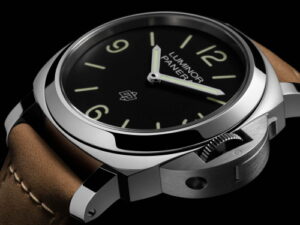
During Pre-Vendome time PVD coating on steel cases was introduced additionally (PVD means “Physical Vapour Deposition”). This combination is called here “PVD steel”, that picture shows you the PAM00195. PVD was replaced by DLC in 2009.
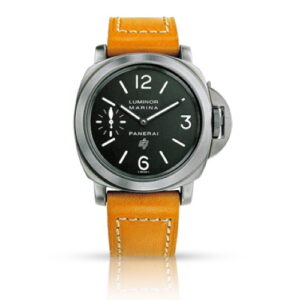
Richmont Panerai introduced from 1998 more and more new case materials.
Platinum (Platinumtech is an alloy variation), introduced with the PAM00021 in 1998, that picture shows you the PAM00715.
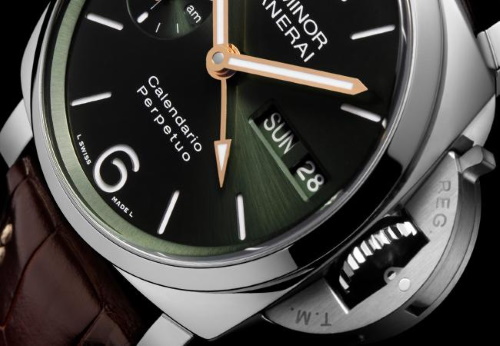
Titanium, introduced with the PAM00025 in 1998, that picture shows you the PAM00619.
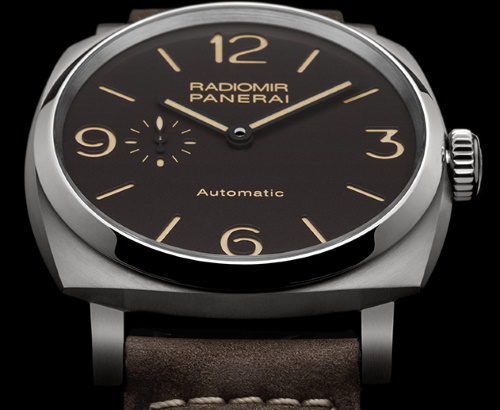
White Gold, introduced with the PAM00045 in 1999, that picture shows you the PAM00503.
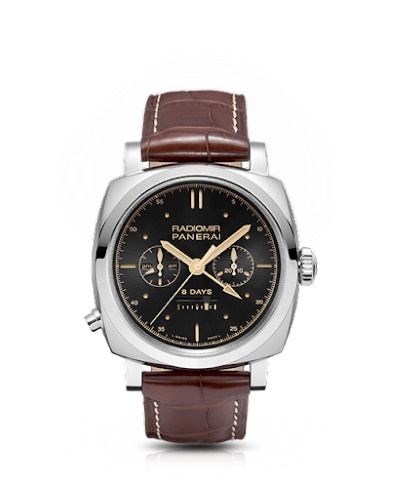
Pink Gold (Goldtech is seen as pink gold variation at Panerai fan-base with gold-copper-platinum-alloy with 72% gold, 24% copper, 4% platinum), introduced with the PAM00100 in 2001, that picture shows you the PAM00659.
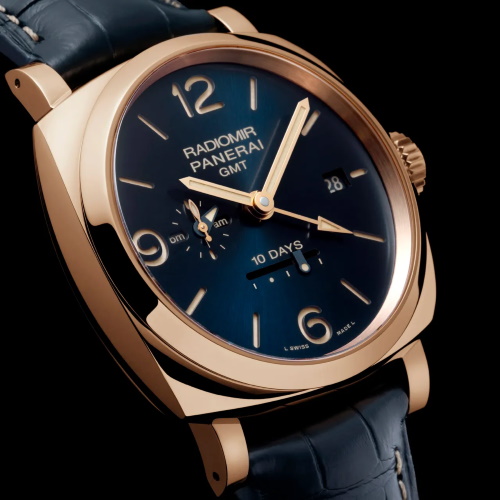
Yellow Gold, introduced with the PAM00140 in 2002, that picture shows you the PAM00269.
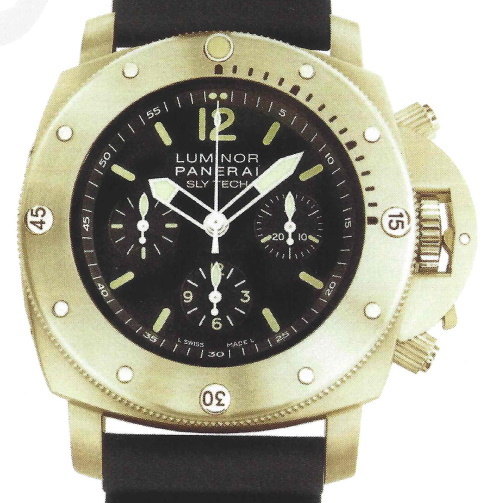
Tantalium, introduced with the PAM00172 in 2003, that picture shows you the PAM00192.
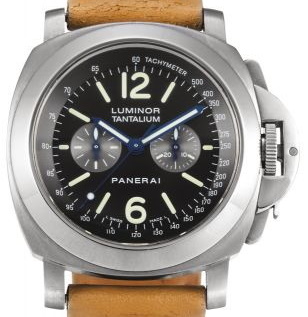
Ceramica, introduced with the PAM00292 in 2007, that picture shows you the PAM00577.
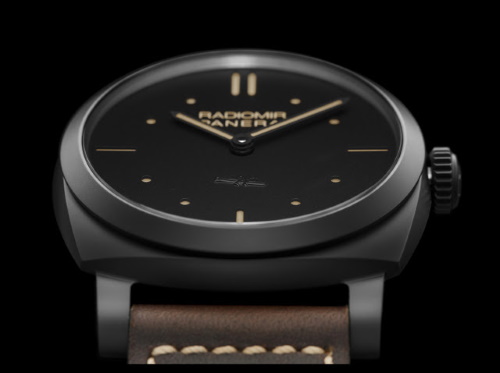
DLC (Diamond-Like-Carbon) coating on steel cases (here called “DLC steel”) was introduced with the PAM00332 in 2009. It replaced the PVD coating at Panerai, because it is more robust, that picture shows you the PAM00332.
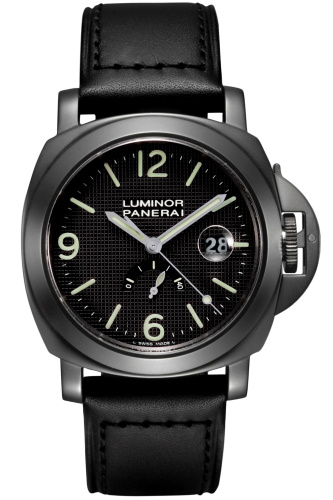
Composite, introduced with the PAM00339 in 2010, that picture shows you the PAM00505.
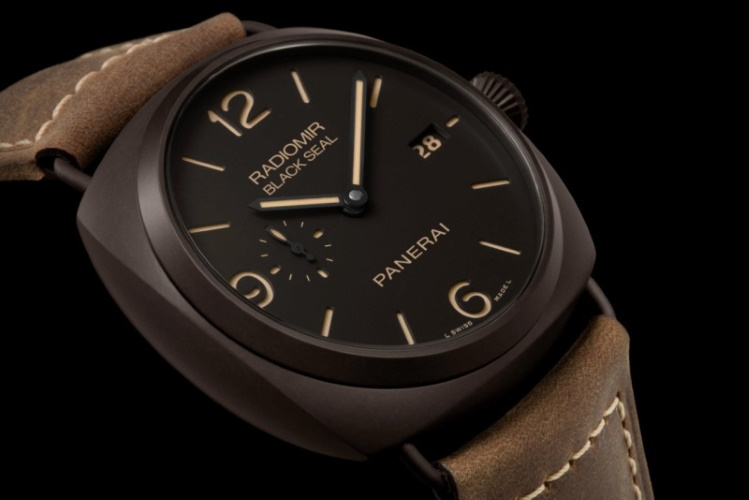
Bronze, introduced with the PAM00382 in 2011, that is shown on the picture.
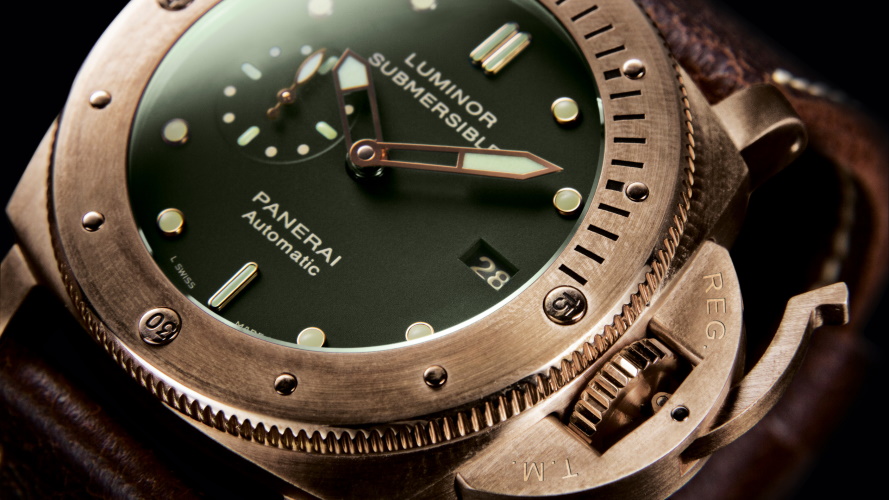
Red Gold, introduced with the PAM00393 in 2012, that picture shows you the PAM01057.
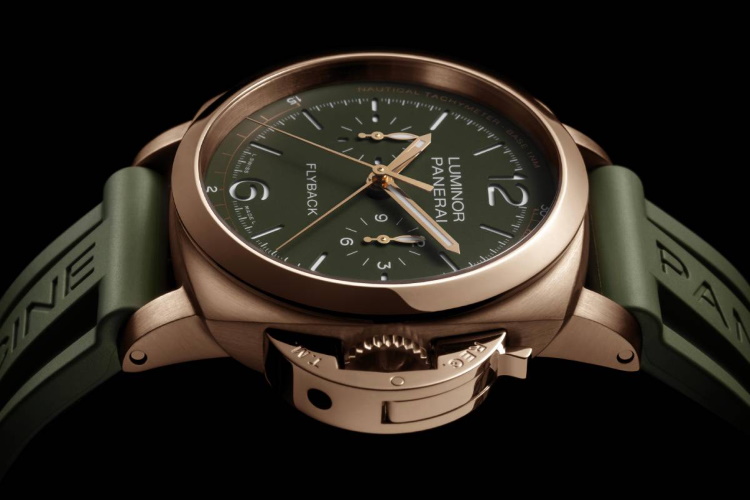
Carbotech, introduced with the PAM00616 in 2015, that is shown on the picture.
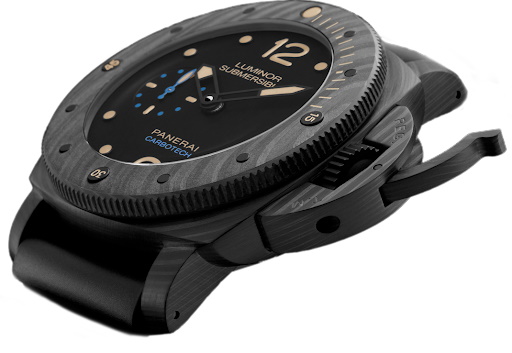
DLC (Diamond-Like-Carbon) on Titanium (here called “DLC Titanium”), introduced with the PAM00617 in 2015, that is shown on the picture.
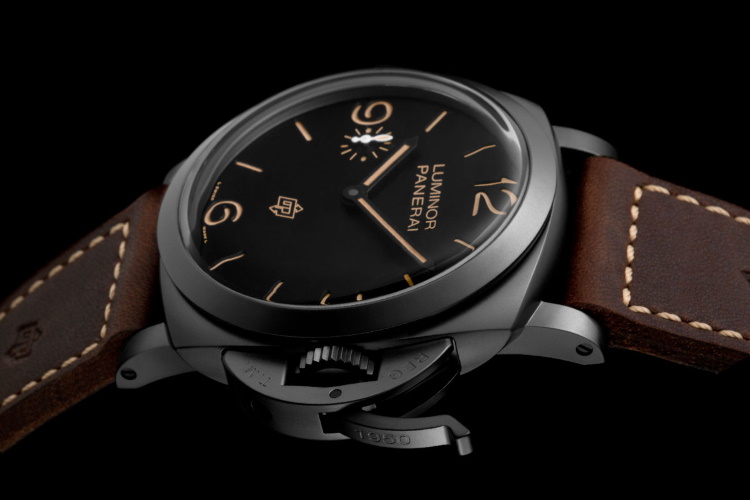
BMG-Tech (Bulk Metallic Glass Technology) on Titanium (here called “BMG Titanium”), introduced with the PAM00692 in 2017, that is shown on the picture.
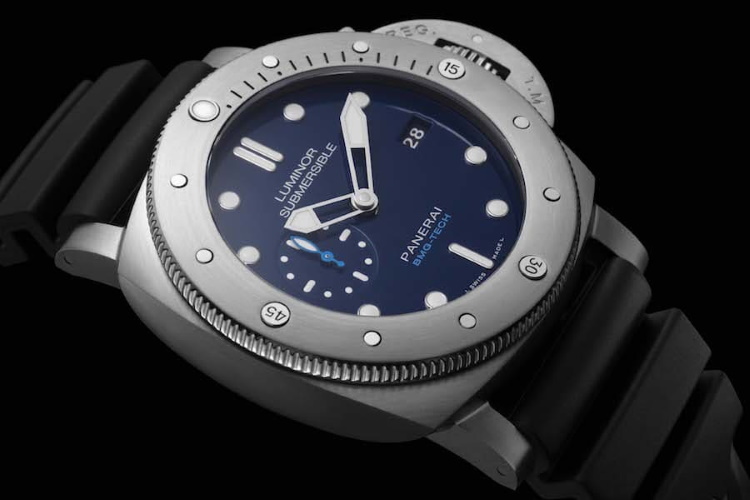
DMLS (Direct-Metal-Laser-Sintering) on Titanium (here called “DMLS Titanium”, introduced with the PAM01099 in 2020, that is shown on the picture.
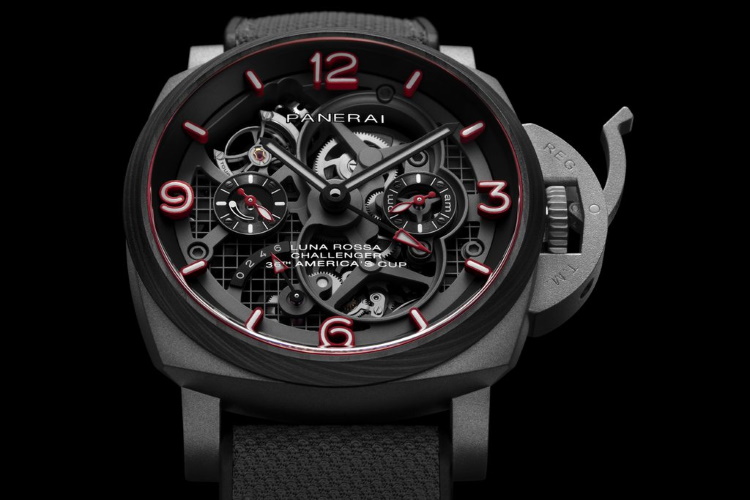
Fibratech (sandwich materials out of mineral fiber from basaltic rock), introduced with the PAM01663 in 2020, that is shown on the picture.
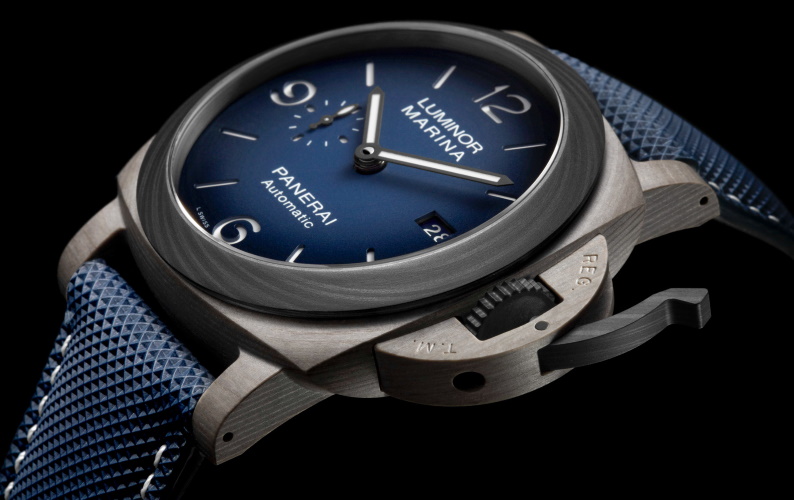
Sandblasted Titanium is a finish to give the watch a more “tool-watch character”, introduced with the PAM01095 in 2020, that is shown on the picture.

Patina (e)Steel is a matt finish to look older, introduced with the PAM01243 in 2021, that is shown on the picture.
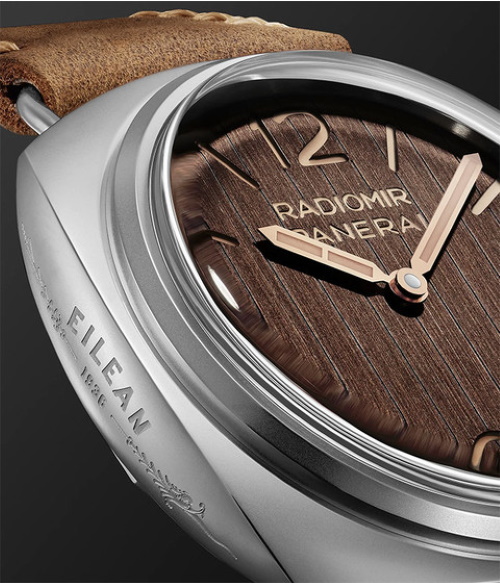
Brunito (e)Steel is a PVD coating with a hand-finish to give the watch a “seasoned used look”, introduced with the PAM01347 in 2023, that is shown on the picture.
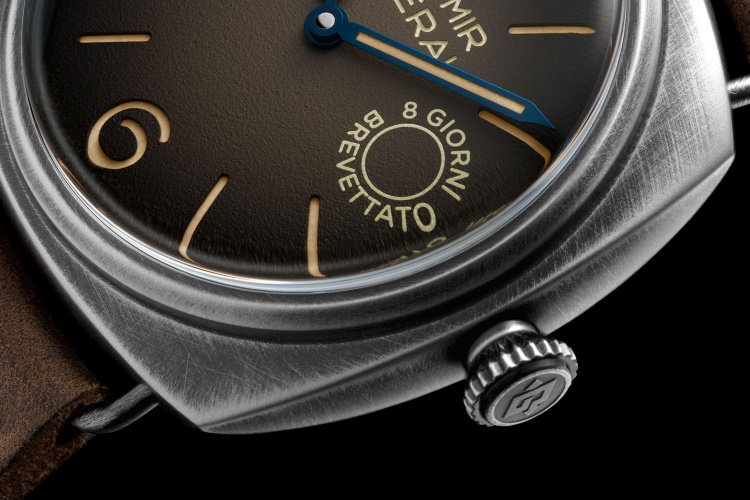
Panerai uses also naming variation because of alloy variations like Platinumtech, Goldtech (gold-copper-platinum-alloy with 72% gold, 24% copper, 4% platinum, from the color a pink gold variation but harder).
Variations in case finish gets namings like EcoPangaea (brushed steel finish).
Wood, Aluminum & glass was used for clocks and instruments cases.
8. Collections
Naming
The Panerai case design has a cushion form that you will find on all Radiomir & Luminor collections (except Mare Nostrum collection). Cushion case design is strongly connected to Panerai, nevertheless it was not designed by Panerai.
Radiomir
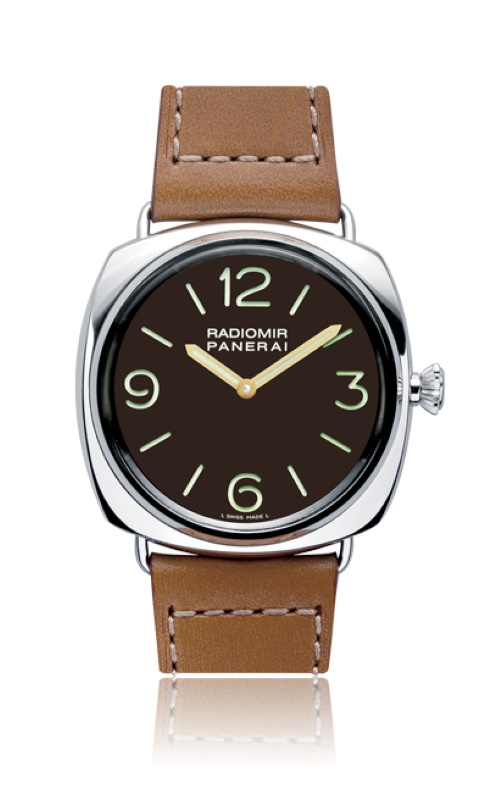
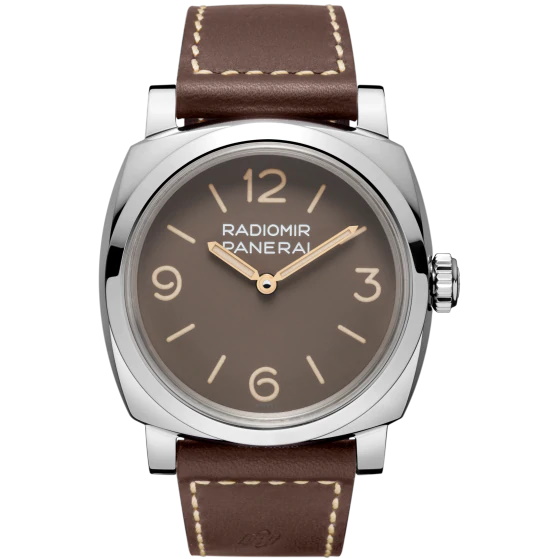
Radiomir 1940
Luminor
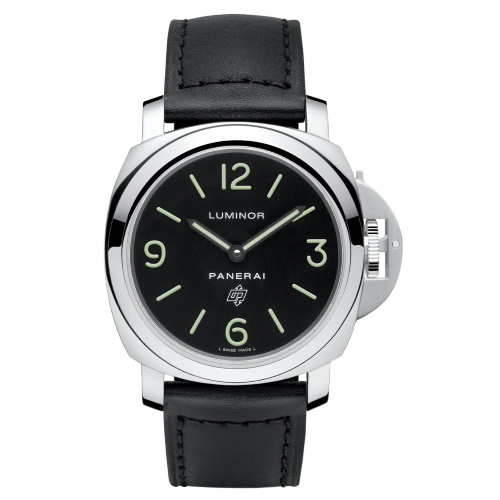
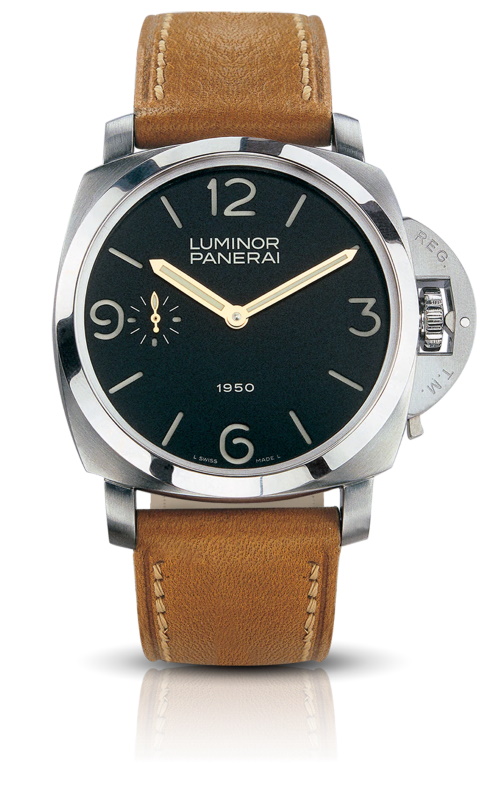
Luminor 1950
Luminor Due
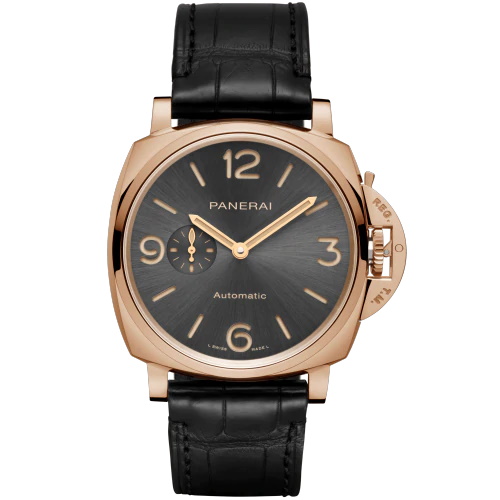
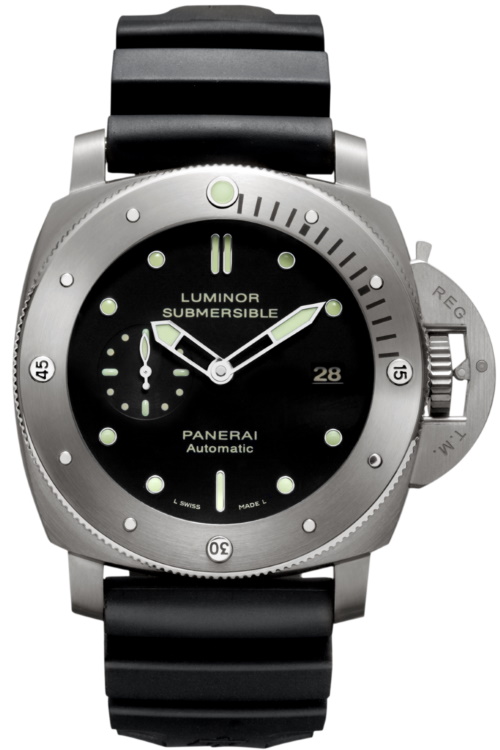
Submersible
Mare Nostrum
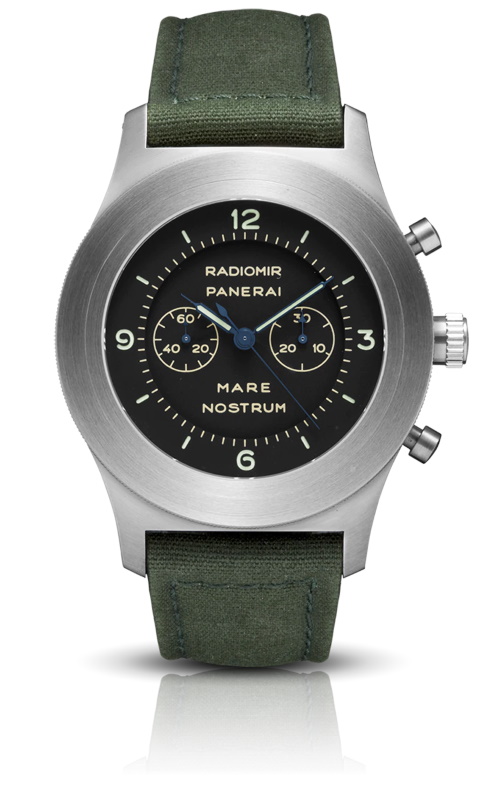
8.1. Namings & Insides
8-DAYS/8 GIORNI
10-DAYS
Base
“Base” as part of the watch naming is used for watches without a second on dial and without a date or other additional functions on dial. Now exists one exception with the PAM00915. The name is “Luminor Base – 44 mm” but has a small second on dial at position 9. That was corrected in 2023 via renaming to “Luminor 8 Giorni”.
Black Seal
Luminor
Marina
Marina Militare
8.2. Inside Luminor collections
Luminor cases (with crown protector)
All Luminor cases looks very similar, nevertheless there are two different main designs. The “Luminor” case (called also Bettarini case in the fan-base) and the “Luminor 1950” case).
Very often Panerai do not differentiate between that two case designs. On the website both sorted under the name “Luminor”. Often the Luminor 1950 reference name has no “1950” as part of the watch name (e.g. Luminor Marina - 42mm PAM02392 with a Luminor 1950 case). Because of that you have to look accurate to detect the case design. The simplest indicator is the crown protector. The Bettarini case has on the top side no engravings, the Luminor 1950 case has the “REG. T.M” engravings on the top side.
9. How-to for the “THE Panerai Reference Database”
The start-screen “https://panerai.watchlounge.com” shows you as overview all the categories & collections.
Select at first the collection you want to search for. You can select “All References” or “All Movements” if you do not know in which collection the searched model belongs. Please be aware that this selection leads to the longest loading time.
The database will load & list all appropriate results (in case of selection “Luminor” all Luminor references, in case of “All References” all references from the database).
Recommendation: The default setup shows you 50 entries per page. You can select on the bottom of the table “Show All entries per page”.
Now you have three possibilities!
Please be aware that the Slideshow can not be used in combination with the other two possibilities, but Filtering & Sorting you can combine.
9.1. Slideshow
The slideshow if the best solution if you want to search via pictures, but you have to scroll top-down over all references. That will need time.
Press “Slideshow” to get the slideshow started.
9.2. Filtering
Filtering is the best solution, if you search for references with specific naming or special features we reflect as part of the naming (e.g. California, Paneristi, Destro, Left-Handed, SLC, etc.)
To filter the result table additionally, you can search for specific naming like “PAM00127” or “127” or “Fiddy” at the “Search:” field. The database will reduce the current result to only the lines where your naming is fitting.
Example 1: Type “destro” at the “Search” filed, you will see around 20 references if you choose “All References” before.
Example 2: Type “Paneristi” at the “Search” filed, you will see around 8 references if you choose “All References” before.
Now you can additionally sort your output via “Sorting”.
9.3. Sorting
Sorting is the best solution, if you search for references with specific features (e.g. all reverences with one specific movement, dial color, size, etc.).
To sort the result table, you have to click on the naming of the specific column. One click is in ascending order (you see it on the small triangle beside the column name, it shows “up”). Second click is sorted in descending order (you see it on the small triangle beside the column name, it shows “down”). Now you can go throw the interesting values within the table.
Example 1: Sort by “Movement” and scroll to the position where the movement “OP I” starts. From now you see all references with that movement
Example 2: Sort by “Case Size” and scroll to the position where the case size 44 mm starts. From now you see all references with that size.
10. Naming & Abbreviation
Here you can find often used naming and abbreviation from the Panerai fan-base.
| Term | Description |
|---|---|
| Bettarini Case | Means the first Luminor case with crown protector (but not the Luminor 1950 case, that was introduced later with the PAM00127) |
| Destro | Left-handed (crown is places vice versa, to where the watch on the other wrist) |
| Dirty dial | Describes the used luminous material color with vintage look (e.g. patina look at a PAM00356) |
| Left-handed | Crown is places vice versa, to wear the watch on the other wrist |
| Luminova | Luminous material is still used by Panerai for classical models. Naming on dial is "L SWISS L", for more details review chapter 6.3 |
| Marina Militare | Means in Italian (military) “Navy”. Panerai references uses sometimes that naming on special editions, nevertheless that naming is not owned or protected by Panerai. |
| Millesimation | See at Millesimation (chapter 2) |
| OOR | See at Out Of Range (OOR) at chapter 2.1 |
| Paneristi | Panerai fan or fan-base |
| Pig | See at S.L.C. |
| PreA | See at Series (chapter 1) |
| Pre-Vendome | Means the time before Richmont bought Panerai (Vendome is the old company name from Richmont) |
| Reference | See at References (chapter 4) |
| Series | See at Series (chapter 1) |
| Shadow Case | See at Shadow Case (chapter 2.2) |
| S.L.C. | Means “Siluro a lenta corsa”, in English language “Slow running torpedo”. That torpedoes were manned. A lot of pictures from Panerai show that manned torpedoes. Panerai uses the name for a specific dial-layout (see chapter 6) and references with that dial. That manned torpedo is applied as small logo on some dials (e.g. PAM00425). That small dial logo is also called “pig” in the Panerai fan-base (to different that form the S.L.C. dial type). |
| Super-Luminova | Luminous material used from approx. 2005 at Panerai. Naming on dial is "L SWISS MADE L". |
| Tritium | Luminous material used until 2006 at Panerai. Naming on dial is "T SWISS T" or "T SWISS MADE T". Radioactive material, replaced by “Super-Luminova”. |
